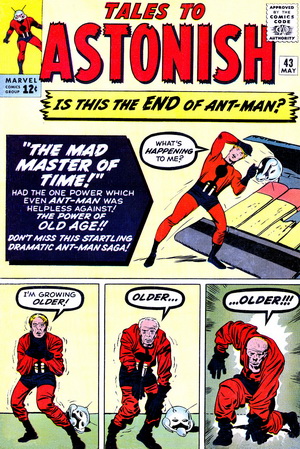
Published: May, 1963
Plot: Stan Lee
Script: Larry Lieber
Art: Don Heck
Letters: Ray Holloway
AGE DISCRIMINATION
Scientist Elias Weems gets fired simply because he is too old. One day, unexpectedly, his boss declares, “It’s our new company policy to discharge all employees over sixty-five years of age.” I read this and right away I’m thinking, “What the—??!!”
Of course I’m approaching this with a 2012 sensibility. It’s flabbergasting to realize there was no real protection for older workers until the 1967 Age Discrimination in Employment Act. In the same vein, it was also not that long ago that blacks, women, homosexuals, or any other minority group, faced discrimination on so many different levels. In some ways, of course, many of these groups still do, though it’s almost certainly nowhere near as blatant as what we read here.
Considering the social climate of the early sixties, it doesn’t read like fiction that someone could be let go from their job so unceremoniously, simply on the basis of their age.
POETIC REVENGE
And it’s not beyond the realm of possibility that an aged ex-employee would become so disgruntled by this discrimination they would want to get even with the society that wronged them. But it’s highly unlikely they would do what Weems does: with his scientific expertise, he creates a ray gun that instantly ages anything it hits.
Weems calls this “poetic revenge.” I think he means “poetic justice,” but yeah—poetic revenge gets the job done. However, at this point, one must ask the obvious question: if Weems is capable of inventing an aging ray, why not put that expertise and energy into making living things young again? Then, not only could he get his job back, and avoid disappointing his grandson, but he would also have the opportunity to live a good portion of his life all over again.
Think how wonderful it would be if you were magically granted the ability to do it all over again! It boggles the mind! If I were Weems, I would concentrate on trying to create a “Youth Gun,” rather than an aging apparatus. If it didn’t work, maybe then I’d consider the revengeful aging scheme. But I certainly wouldn’t start my scientific exploration there.
I would have liked to read a panel like this:

That would have gone a long way to explaining why our (supposedly) kind-hearted villain didn’t consider the most obvious solution before settling on his dastardly plan.
Anyway, after creating the ray gun, Weems tests it on plants, then animals, and finally human beings, before issuing his ultimatum to the police—unless the city is surrendered to him, he’ll make everyone old before their time!
Now here’s where the story starts to fall apart for me. When we first meet Weems, he is a kind grandfatherly type, misty-eyed over an upcoming visit from grandson Tommy. But after being fired, he’s so upset that not only does he want to make everyone else in the city old like he is, but his primary demand is to be crowned “boss of the city.” This guy has completely lost it! And if you don’t believe me, check out these excellent before-and-after pics from artist Don Heck:

Pushed over the edge, Weems is now 100% mad scientist. He’s not simply interested is applying a little “poetic revenge,” he’s a power-hungry maniac, along the lines of the Puppet Master, Mole Man, or even Doctor Doom!
ONLOOKER
 Now…I wish I could say our hero Ant-Man steps in to save the day (remember, this is a review of an Ant-Man comic) but as a matter of fact, Ant-Man is more or less furniture. Scenery. He doesn’t do much. True, Pym uses his Sherlock Holmes brain to do some detective work and figure out who’s threatening to cripple the city with geriatric gusto, but even Inspector Clouseau could have done that!
Now…I wish I could say our hero Ant-Man steps in to save the day (remember, this is a review of an Ant-Man comic) but as a matter of fact, Ant-Man is more or less furniture. Scenery. He doesn’t do much. True, Pym uses his Sherlock Holmes brain to do some detective work and figure out who’s threatening to cripple the city with geriatric gusto, but even Inspector Clouseau could have done that!
Once Pym appears as Ant-Man, Weems simply makes him old and sticks him in a flower pot. But that doesn’t keep Ant-Man down for long! He takes a swig of his enlarging serum to get out of the flower pot, but in order to reverse his age, he must track down Weems.
This he does, as the villain is easily spotted atop a tall building, attacking the crowd below with his aging gun. But it’s not Ant-Man that saves the day, oh no! More exactly, Weems comes to his senses when he accidentally shoots and ages grandson Tommy, newly arrived for his visit with Grandpa.
Mortified that he’s aged his beloved relative, Weems hardly needs Ant-Man to instruct him to reverse the controls on the gun and turn everybody back to their original ages. I feel certain Weems would have done that on his own, because when he’s thinking clearly, he remembers that what matters most to him is the love of his grandson.
FORGIVE AND FORGET?
 I say “when Weems is thinking clearly,” because this story is obviously a morality tale about someone who has been so wronged by society that he temporarily goes off the deep end. Ant-Man steps in as his advocate, telling the judge that society is to blame.
I say “when Weems is thinking clearly,” because this story is obviously a morality tale about someone who has been so wronged by society that he temporarily goes off the deep end. Ant-Man steps in as his advocate, telling the judge that society is to blame.
Now, Ant-Man must be a mighty fine orator, because apparently that’s all the judge needs to hear to say, “You know, you’re right, little man. Weems is just a poor fella who was down on his luck. We can’t really blame him for trying to take over the city. I’m sure he didn’t mean any harm.” [Bangs Gavel.] “Dismissed! Get him out of here! Oh, and Weems…just don’t do it again, okay?”
Earlier I was flabbergasted by the blatant display of age discrimination, but was able to put it down to a sign of the times. However, I don’t know if I can so easily dismiss this lax doling out of justice. Not only does Weems suffer no consequences for his illegal acts, but he also gets his job back—though I think his smarmy employer is wisely operating under the maxim “Keep your friends close…and your enemies closer.” The last we see of Weems, he’s proudly showing Tommy all around the laboratory, as if nothing had ever happened.
 What’s that all about? In the 60’s, were despotic criminals set free because society had treated them badly? I don’t think so. The nearest we have to this today is the “celebrity justice” that allows young starlets to suffer a few days in jail rather than the extended prison incarceration visited upon wrongdoers with the misfortune to be not as rich, famous, or pretty.
What’s that all about? In the 60’s, were despotic criminals set free because society had treated them badly? I don’t think so. The nearest we have to this today is the “celebrity justice” that allows young starlets to suffer a few days in jail rather than the extended prison incarceration visited upon wrongdoers with the misfortune to be not as rich, famous, or pretty.
But Weems is none of those things, so the only way I can wrap my head around this injustice is to remind myself that I’m reading a comic book, aimed at kids, and the writers are simply trying to make a point. And that point is…is…
Actually, I’m not sure what the point is. In the next to the last panel, Weem’s employer says, “I’ve learned my lesson! Never again will I judge a man’s worth solely on the basis of his age!” A good clean thought, worth drumming into young minds.
I kind of thought that was the moral of the story, but then in the last panel, Ant-Man adds, “In a way, we’ve all learned something! We’ve learned to appreciate our youth, and strength, and to make the most of them while we can, the better to serve humanity!”
Wait…WHAT? I didn’t see that anywhere in the story, did you? I mean, it’s a nice sentiment and all, but it just isn’t there. So the last panel has me saying “HUH?” even moreso than everything that came before.
I haven’t reviewed a lot of Ant-Man stories, but after this one, I feel the series needs help. It’s odd enough having a hero that gets really, really small, but then to show him pontificating from among the ants as his strongest act of heroism…well, it’s time to pump some new blood into the mythos! And that’s coming up in the next issue, with the introduction of Ant-Man’s fiery female sidekick…the Wasp!
![]() I love the Wasp, and can’t wait to write about her. But I think I’ll have to wait a while, because I think the next story I cover here will generate a lot of thought, and I don’t think I want to miss that!
I love the Wasp, and can’t wait to write about her. But I think I’ll have to wait a while, because I think the next story I cover here will generate a lot of thought, and I don’t think I want to miss that!
| Want to read this comic on your computer? Marvel has a scan! Want to own this story? Buy the Masterworks! |














